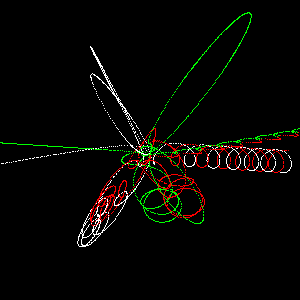
Interaction of a binary with a single star
The core collapse was predicted theoretically by Donald Lynden-Bell and Roger Wood in 1968. It occurs generically in any stellar system that is old enough to have redistributed the energies between the stars. As seen in Hénons model, the core transfers its energy to the outer envelope, causing some thermal difference between the two regions. Initially small differences will be enhanced, and the larger they get, the more flux is transfered. Since this process does not come to an end, no equilibrium can be achieved in the core, and it collapses.
| The runaway process is only halted when binary stars form at the centre through 3-body encounters. This may happen e.g. when a single star passes two others, which may or may not be already a physical pair. If the passage is close enough, it interacts with the individual components seperately. These interactions can be very complex in general, resulting in the formation of a temporary triple-star system, the disruption of the former binary, or the exchange of partners. The figure shows a typical interaction between the stars: a single star (green) comes in from the left and meets a binary from the right (red + white). After the dissociation of the binary, a chaotic behaviour sets in wherein different other orbits are formed and disrupted (red + green), and in the end, a harder binary than before (more tightly bound) is created, while one spare star escapes to infinity. |

Interaction of a binary with a single star |
It should be noted that the simulation provides a simplified
view and real circumstances are very much more complicated.
The analysis of close encounters of a binary with one single
star does not exhaust the possible effects.
During the late stages of core collapse, binary-binary encounters
are likely to predominate binary-single ones, making the
investigation more difficult.
Thus, the formation process of hard binaries provides a huge
reservoir of energy; the binding energy of a hard binary can
"store" the total energy of the whole cluster!
And this is how the the core collapse is halted:
Binary formation reverses the outward flow of energy and
stabilizes against singularity.
 3. Models of Globular Clusters
3. Models of Globular Clusters
|
| | 5. Towards new challenges

|
| Contents page | ||